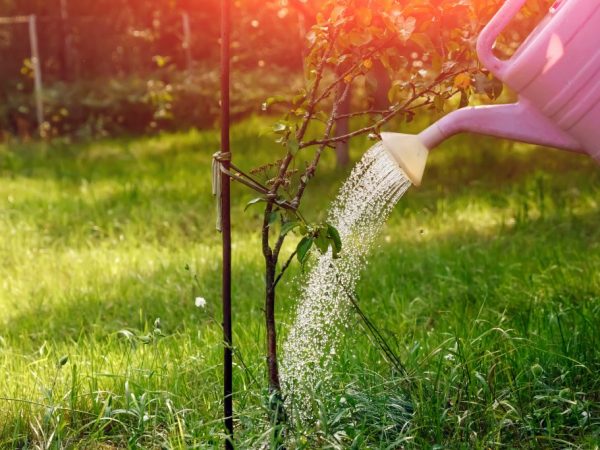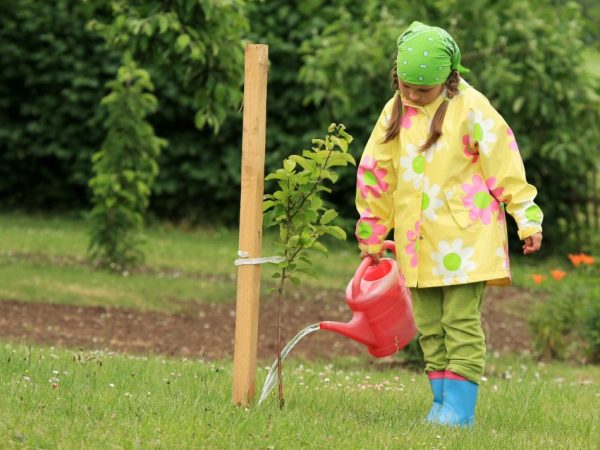Spring feeding rules for apple trees
Trees have been growing in one place for several decades. All this time, they actively consume nutrients from the soil on which they grow. Spring feeding of apple trees is a necessary procedure. Nutrient deficiencies can negatively affect the yield.

Spring feeding rules for apple trees
Fertilization timing
Spring and autumn are 2 important periods for tree fertilization.
Spring feeding of the apple tree is carried out in 3 stages, limited by the time frame:
- beginning - mid-March - top dressing before flowering;
- mid-April - fertilization during flowering;
- beginning - mid-March - feeding after flowering.
Timely introduction of complex mixtures in spring helps to increase the yield.
Views
In gardening, mineral, organic and complex fertilizers are used. There is a difference between them. You can use these fertilizers for root and foliar feeding.
Mineral
The use of mineral fertilizers is often neglected. There is an opinion about their harm to human health and the plant itself, but it is erroneous. Compliance with dosages and recommendations for use will only benefit your garden.
You need to understand what mineral fertilizers should be and how to properly feed the crop so as not to harm it.
Nitrogen
Nitrogen fertilizing is applied under the apple trees in the spring to help the tree "wake up" after winter and build up a sufficient number of new branches and leaves for a healthy crown.
Nitrogen-containing fertilizers can be used as needed and in the summer. Lack of nitrogen can provoke yellowing of the foliage and its early fall, which will lead to a disruption in the biological cycle of the tree and its susceptibility to disease.
When using this type of fertilizer, always read the instructions carefully. The correct dose does not affect the growth and quality of the fruit, but in case of an overdose, its elements will get into the apples, and they will become dangerous for consumption. Excessive nitrogen can burn the root system.
The following nitrogen fertilizers are suitable for apple trees: urea, sodium, ammonium and calcium nitrate, ammonium sulfate.
Phosphoric
Nitrogen is not assimilated sufficiently without adding it in combination with phosphorus. The latter is needed for active growth and development of the root system of the tree, timely abundant flowering and the appearance of ovaries.

Fertilize with nitrogen with phosphorus
Lack of phosphorus manifests itself in the color of the leaves, uncharacteristic for apple trees, with a purple or silver tint on the underside.
The amount of this element in fertilizers of animal origin is minimal, it is not enough. Introduce simple or double superphosphate or phosphate rock at the rate of 200 g per 1 m².
Potash
Potassium is essential for young trees. It stimulates the full development of the tree, helps it to get stronger. Fertilizer is applied under mature trees so that it helps the tree to survive the summer heat and frosty winter, i.e.this top dressing gives the apple tree resistance in extreme temperatures.
The following potash fertilizers are recommended: potassium sulfate, potassium magnesium, potassium salt.
An important nuance: such dressings are introduced in the fall, by the spring they should have time to decompose, and their elements should be released and become available to the tree.
Organic
Organic food is in constant demand. Gardeners try to constantly "pamper" their plots with this type of fertilizer. Knowing the useful properties and features of the use of each of their types, you can achieve greater efficiency when growing apple trees.
Fresh manure
Using fresh manure requires a delicate approach. It contains ammonia, an excess of which can harm the roots and lead to the death of an unformed tree. Fertilizing with manure will have a positive effect on the amount of the crop.
In order for the ammonia to evaporate, it is enough to withstand the slurry for a week and only then bring it into the digging.
Humus
Humus is decomposed plant and animal residues. This type of fertilizer is safer than fresh mullein, because organic matter has already decomposed and all aggressive substances are neutralized. Introduced at the rate of 10 kg per 1 m².
Bird droppings
The nitrogen content of poultry manure is higher than any other organic fertilizer. It is brought in in small doses in the spring. In the fall, droppings can provoke unwanted branch growth for the winter.
For plowing, a dry product is used, and for liquid fertilizing during the growing season, the droppings are diluted in water at the rate of 100 g per 10 liters and infused for 10 days.
Wood ash
Ash is used to protect the garden from pests and diseases (fungi and putrefactive infections). It deacidifies the soil. By introducing wood ash, you can not enter potash fertilizers: 1 tbsp. ash replaces 10 g of any such fertilizer.
Bone flour
This organic fertilizer contains a high content of nitrogen and calcium. Like wood ash, it is used to deoxidize the soil. Bone meal should be fed to trees in spring or summer. You can add powder in dry form or liquid, diluted with water.
Fertilizing old trees
To fertilize old trees, you need to dig up the soil to a depth of 40 cm, which is equal to one bayonet of a garden shovel.
It is allowed to feed adult apple trees in the spring by digging holes or furrows (5-10 pieces) along the diameter of the crown. Their depth is 35-50 cm. Their size depends on the height of the tree. A dwarf variety is enough 35-40 cm, and for tall ones you need at least 50 cm.
These holes are covered with a soil mixture with the addition of fertilizers. By introducing dry dressing, you can then water it. The liquid method of application allows the roots to immediately receive useful substances.
Apple trees over 10 years old are more demanding in their care. Because their development stops, the strength of the tree and your care should be aimed at restoring the roots and crown after wintering. The following composition of fertilizer is recommended for such apple trees in the spring: mullein (3 kg), urea (30 g), potassium sulfate (20 g), superphosphate (40 g) and water (30 l) - per 1 m².
Fertilizing young trees

Loosen the earth and water
When applying fertilizers under young trees, and they are considered such at the age of 1-3 years, it is enough to dig the soil to a depth of 20 cm.
You can fertilize seedlings by deep loosening of the soil. To do this, you need to moisten the trunk circle well. After that, the soil is loosened deeply and fertilizers are laid along the diameter of the crown at a distance of no closer than 25 cm to the trunk.
If you made replenishment when planting, it will not be required in the first year of the tree's life. In the spring, the following composition is suitable for fertilizing young apple trees: bird droppings (1 kg), simple superphosphate (1 kg), potassium sulfate (700 g), water (15 l).
The dependence of feeding on flowering
At different stages of development, apple trees in the spring need certain types of feeding.
Before flowering
The first feeding takes place before flowering, from early to mid-March. At this time, nitrogen-containing substances are introduced only for fertilizing the roots; foliar feeding is not required at this stage. You should work according to the following scheme:
- loosen the soil;
- prepare top dressing (one of your choice): ammonium sulfate (25 g per 5 l of water), potassium sulfate (no more than 5 g per 5 l of water), ammonium nitrate (40 g per adult tree, 20 g - per young per 10 l of water );
- the mixture is introduced at a distance of 0.5 m from the trunk.
During flowering
During flowering, fertilization of the root system of the tree continues, foliar feeding is not needed. It is necessary to fertilize the apple tree from the beginning to the middle of April according to the following scheme:
- a mixture is prepared with the following composition: 800 g of potassium sulfate, 1 kg of superphosphate, 5 liters of poultry droppings or 500 g of urea, 200 liters of water;
- the mixture is infused for 7 days;
- you need to feed the tree with this mixture at a distance of 50-60 cm from the trunk.
After flowering
After the end of the flowering period, from the beginning to mid-May, it is necessary to carry out the next dressing. Now it is necessary to fertilize not only the roots, but also the crown by spraying according to this scheme:
- we dilute urea at the rate of 50 g per 1 liter of water;
- we spray the tree with a spray bottle.
We fertilize the root zone as follows:
- prepare a mixture of 1 g of dry sodium humate and 50 g of nitrophoska, dissolve in 10 liters of water;
- pour into the root zone in the evening.
Top dressing is applied to keep the tree healthy. Compliance with the recommendations for the introduction of fertilizing, incl. spring, is part of the proper care of the apple orchard.

